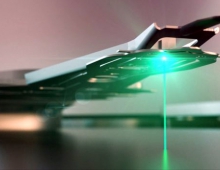
SDK Develops Organic EL Devices with Light Output of 40 Percent
Showa Denko K.K. (SDK) has developed a new structure for its organic electroluminescent (organic EL) devices, achieving approximately 40% in light output, which represents the highest level in the world.
SDK claims that it has achieved a 30 lm/W emissive efficiency for its coated phosphorescent-polymer-based organic EL devices. ("Emissive efficiency" refers to the quantity of light emitted from light source, divided by electric power consumed.) The 30 lm/W emissive efficiency represents the highest level among coated-type organic EL devices that have been announced in the world.
The company has been developing a coated-polymer type (easy to make large area-emission organic EL panels) and a phosphorescent type (with high potential for increased emissive efficiency). As a result, SDK expects its organic EL devices with the new structure to be used widely for general lighting applications in the future. The company is currnetly working with SRI International, a non-profit research organization based in California, U.S.A., and Itochu Plastics Inc. (CIPS), of Japan, to promote the development of coated phosphorescent-polymer-based organic EL devices for early commercialization in the organic EL lighting market.
In terms of the production process, organic EL devices are classified into a deposition type and a coated type. The former generally has a multilayered structure of low-molecular-weight-compounds laminated through deposition processes under vacuum. Its production technology has almost been established, making it ready for volume production. However, its production cost is high, and there are many issues to be solved in producing a large area-emission panel based on this device. Meanwhile, the coated type is attracting keen attention because it consists of a few layers formed by coating polymer without the use of vacuum, providing the opportunity for substantial cost reductions and for the production of large area-emission panels in the future.
Organic EL devices are also classified by the emission method, into a fluorescent type and a phosphorescent type. At present, the former has longer life and is already used in displays of mobile phones. Meanwhile, emissive efficiency (lm/W) of the phosphorescent type can theoretically become four times that of the fluorescent type.
While the conventional-type device has a structure of cathode, emitter, anode, and glass substrate, the new structure has introduced a layer of dielectric/heat conductor that adjusts reflection of light. The new layer helps reduce the percentage of light trapped in the device, improving the light output. The dielectric/heat conductor layer, having high heat dissipation efficiency, prevents heat deterioration of the emitter, prolonging the device life.
SDK has already achieved a luminance half life of approximately 10,000 hours for white lighting through improvements in the phosphorescent-polymer materials. The company plans to continue developing organic EL devices with longer life based on the successful development of the new device structure.
SDK, SRI International and CIPS will work together to improve the design of device structure and start selling samples on a full scale in 2010 for use in the general lighting market. The three parties will also work to improve coating property of the phosphorescent polymer and prolong the device life, aiming to achieve a 150 lm/W emissive efficiency and a luminance half life of approximately 50,000 hours for white lighting by 2015. Thus, SDK is planning to commercialize its coated phosphorescent-polymer-based organic EL devices for general lighting by achieving high levels of performance exceeding that of fluorescent lamps.

The company has been developing a coated-polymer type (easy to make large area-emission organic EL panels) and a phosphorescent type (with high potential for increased emissive efficiency). As a result, SDK expects its organic EL devices with the new structure to be used widely for general lighting applications in the future. The company is currnetly working with SRI International, a non-profit research organization based in California, U.S.A., and Itochu Plastics Inc. (CIPS), of Japan, to promote the development of coated phosphorescent-polymer-based organic EL devices for early commercialization in the organic EL lighting market.
In terms of the production process, organic EL devices are classified into a deposition type and a coated type. The former generally has a multilayered structure of low-molecular-weight-compounds laminated through deposition processes under vacuum. Its production technology has almost been established, making it ready for volume production. However, its production cost is high, and there are many issues to be solved in producing a large area-emission panel based on this device. Meanwhile, the coated type is attracting keen attention because it consists of a few layers formed by coating polymer without the use of vacuum, providing the opportunity for substantial cost reductions and for the production of large area-emission panels in the future.
Organic EL devices are also classified by the emission method, into a fluorescent type and a phosphorescent type. At present, the former has longer life and is already used in displays of mobile phones. Meanwhile, emissive efficiency (lm/W) of the phosphorescent type can theoretically become four times that of the fluorescent type.
While the conventional-type device has a structure of cathode, emitter, anode, and glass substrate, the new structure has introduced a layer of dielectric/heat conductor that adjusts reflection of light. The new layer helps reduce the percentage of light trapped in the device, improving the light output. The dielectric/heat conductor layer, having high heat dissipation efficiency, prevents heat deterioration of the emitter, prolonging the device life.
SDK has already achieved a luminance half life of approximately 10,000 hours for white lighting through improvements in the phosphorescent-polymer materials. The company plans to continue developing organic EL devices with longer life based on the successful development of the new device structure.
SDK, SRI International and CIPS will work together to improve the design of device structure and start selling samples on a full scale in 2010 for use in the general lighting market. The three parties will also work to improve coating property of the phosphorescent polymer and prolong the device life, aiming to achieve a 150 lm/W emissive efficiency and a luminance half life of approximately 50,000 hours for white lighting by 2015. Thus, SDK is planning to commercialize its coated phosphorescent-polymer-based organic EL devices for general lighting by achieving high levels of performance exceeding that of fluorescent lamps.






















